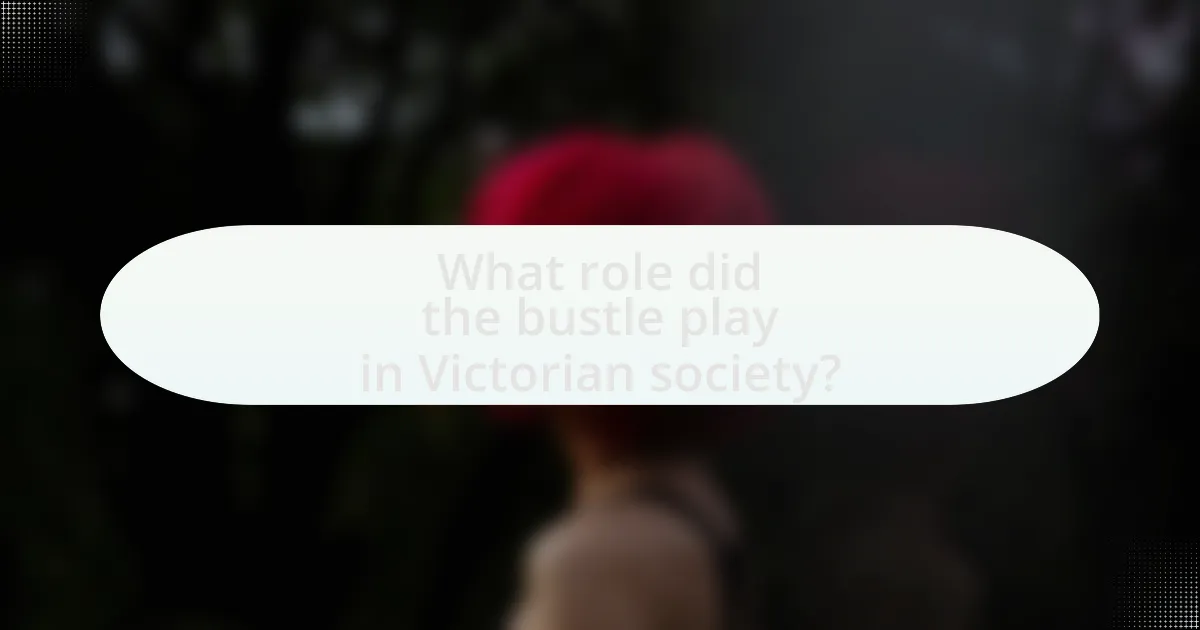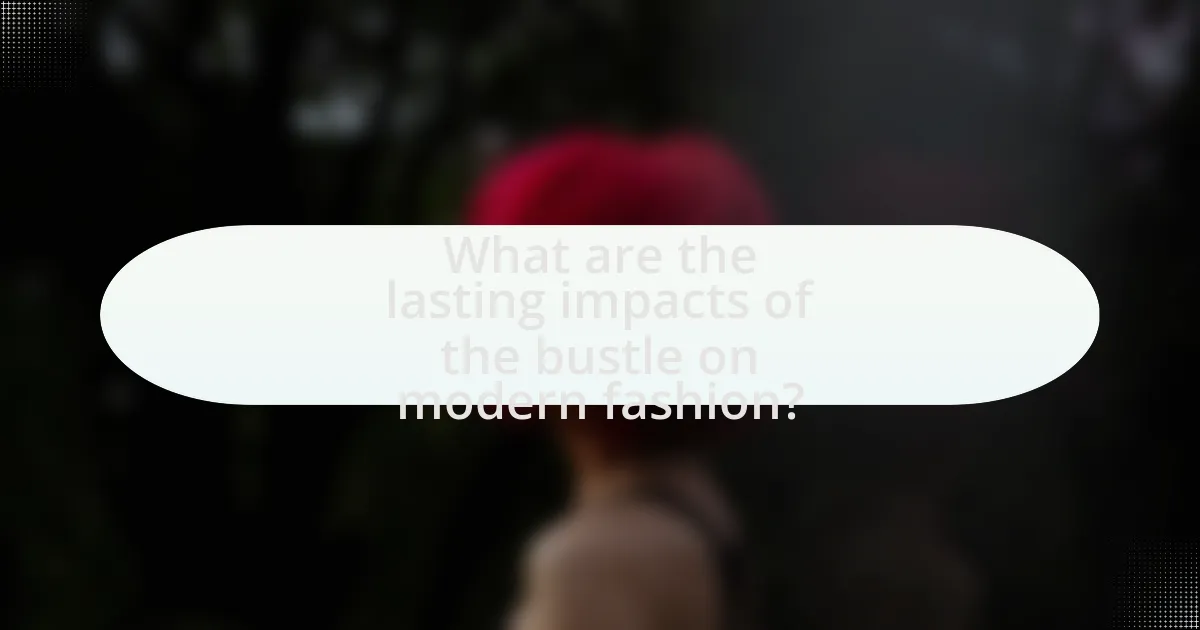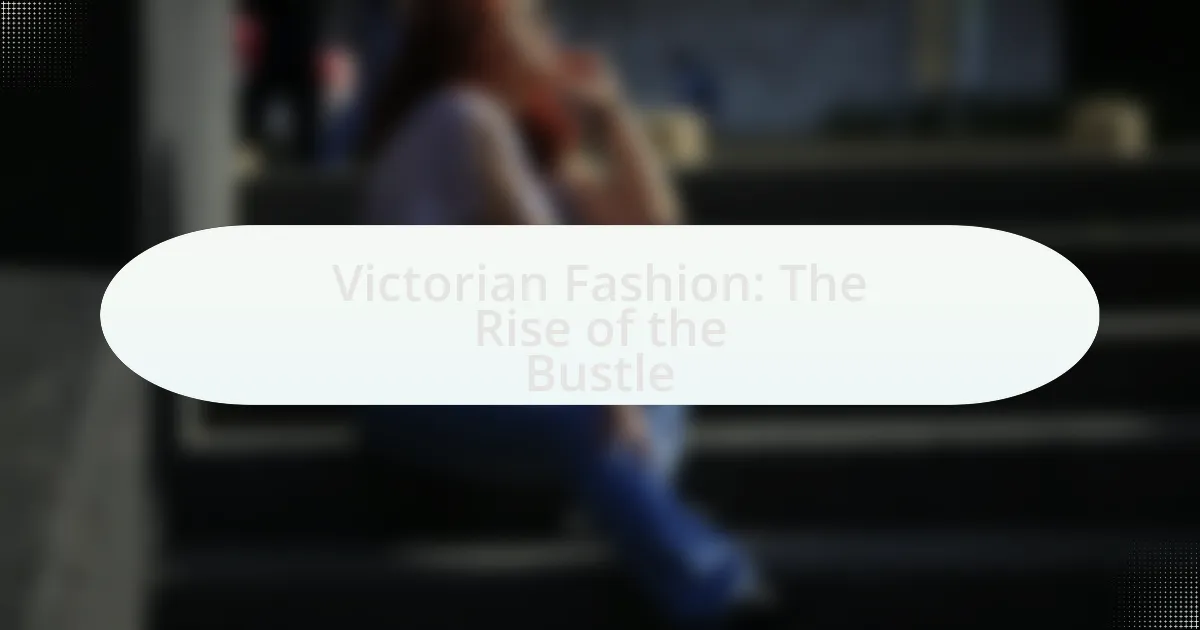Victorian fashion, particularly during the reign of Queen Victoria from 1837 to 1901, is characterized by elaborate designs and structured silhouettes, with the bustle emerging as a defining feature in women’s clothing from the mid to late 19th century. The bustle accentuated the back of dresses, creating a fuller silhouette that emphasized the waist and hips, reflecting societal norms of femininity and elegance. Influenced by historical events such as the Industrial Revolution and the women’s suffrage movement, the bustle became a symbol of wealth and status while also shaping perceptions of women’s roles and femininity. The article explores the characteristics, materials, and evolution of the bustle, its implications for women’s fashion and societal expectations, as well as its lasting impact on contemporary fashion trends.

What is Victorian Fashion and the Bustle?
Victorian fashion refers to the clothing styles that were popular during the reign of Queen Victoria from 1837 to 1901, characterized by elaborate designs, structured silhouettes, and a focus on modesty. The bustle, a specific feature of Victorian women’s fashion, emerged in the mid to late 19th century, designed to accentuate the back of the dress and create a fuller silhouette. This fashion trend was marked by the use of padded undergarments or frameworks that supported the fabric, allowing for a pronounced shape that emphasized the waist and hips. The bustle became a defining element of women’s attire, particularly in the 1870s and 1880s, reflecting societal norms of femininity and elegance during the Victorian era.
How did the bustle become a defining feature of Victorian fashion?
The bustle became a defining feature of Victorian fashion due to its role in enhancing the silhouette of women’s dresses, particularly during the late 19th century. This fashion element emerged as a response to changing aesthetic preferences, where a fuller back was desired to create an hourglass figure, which was considered fashionable and desirable at the time. The introduction of the bustle coincided with the 1870s, when designers began to manipulate fabric and structure to achieve this effect, leading to its widespread adoption in women’s clothing. Historical records indicate that by the 1880s, the bustle had become a staple in women’s fashion, influencing dress designs and social norms surrounding femininity and beauty.
What historical events influenced the rise of the bustle?
The rise of the bustle was influenced by several historical events, particularly the Industrial Revolution and the changing social dynamics of the Victorian era. The Industrial Revolution, which began in the late 18th century, led to increased production capabilities and the availability of new materials, allowing for more elaborate and structured garments. Additionally, the women’s suffrage movement and the push for greater social freedoms in the late 19th century encouraged women to adopt fashion that emphasized their changing roles in society, leading to the popularity of the bustle as a symbol of femininity and modernity. The 1870s saw the bustle become a prominent feature in women’s fashion, reflecting both the technological advancements in textile production and the evolving cultural attitudes towards women’s rights and identity.
How did societal norms shape the design of the bustle?
Societal norms significantly influenced the design of the bustle by emphasizing femininity and an exaggerated silhouette that reflected the ideals of beauty during the Victorian era. The bustle, which emerged in the mid-19th century, was designed to create a pronounced back profile, aligning with the cultural expectation for women to embody an hourglass figure, which was considered fashionable and desirable. This design choice was a direct response to societal pressures that dictated women’s roles as symbols of virtue and domesticity, reinforcing the notion that women should appear delicate and ornamental. Historical evidence shows that the bustle became a prominent feature in women’s fashion from the 1870s to the 1890s, as it allowed for the display of wealth and status through elaborate fabrics and intricate designs, further solidifying its connection to societal norms of the time.
What were the key characteristics of the bustle?
The key characteristics of the bustle included a pronounced emphasis on the back of the dress, creating a voluminous silhouette that accentuated the waist and hips. This fashion trend emerged in the mid to late 19th century, particularly during the Victorian era, and was often constructed from various materials such as crinoline, horsehair, or padding to achieve the desired shape. The bustle allowed for a more structured and dramatic appearance, often paired with fitted bodices and elaborate skirts, reflecting the social norms and aesthetics of the time. Historical records indicate that the bustle evolved through different styles, including the “first bustle” in the 1870s and the “second bustle” in the 1880s, showcasing its adaptability and significance in Victorian fashion.
What materials were commonly used in bustle construction?
Common materials used in bustle construction included steel, whalebone, and cotton. Steel provided the necessary structure and support, while whalebone offered flexibility and shape. Cotton was often used for the outer fabric, allowing for a variety of styles and designs. These materials were integral to the bustle’s functionality and aesthetic appeal during the Victorian era, reflecting the fashion trends of the time.
How did the silhouette of the bustle evolve over time?
The silhouette of the bustle evolved significantly from the mid-19th century to the early 20th century. Initially, the bustle created a pronounced back profile, emphasizing a rounded shape that was popularized in the 1860s and 1870s. As fashion progressed into the 1880s, the bustle became more exaggerated, with larger and more structured designs that extended further back, often supported by various undergarments. By the 1890s, the silhouette shifted towards a more streamlined look, with the bustle becoming less prominent and more integrated into the overall dress design, leading to a flatter back. This evolution reflects changing aesthetic preferences and social norms of the Victorian era, as well as advancements in textile technology and garment construction.

What role did the bustle play in Victorian society?
The bustle played a significant role in Victorian society by shaping women’s fashion and reflecting social status. Introduced in the mid-19th century, the bustle accentuated the back of women’s skirts, creating a silhouette that emphasized femininity and modesty. This fashion trend was not merely aesthetic; it symbolized the societal expectations of women during the Victorian era, where propriety and decorum were paramount. The bustle also allowed for the display of wealth, as elaborate designs and materials indicated higher social standing. Historical records show that the bustle became a staple in women’s wardrobes from the 1870s to the 1890s, influencing both everyday attire and formal wear, thus reinforcing the cultural norms of the time.
How did the bustle reflect social status and class distinctions?
The bustle reflected social status and class distinctions by serving as a symbol of wealth and fashion consciousness among the upper classes in Victorian society. The elaborate design and materials used in bustles, such as silk and lace, indicated affluence, as only the wealthy could afford such luxurious fabrics and the skilled labor required for intricate tailoring. Additionally, the prominence of the bustle in women’s fashion during the late 19th century showcased the societal expectation for women of higher social standing to adhere to specific beauty standards, which emphasized a curvaceous silhouette. This emphasis on fashion not only differentiated the upper classes from the working class but also reinforced gender roles, as women were often judged based on their adherence to these trends.
What were the implications of bustle fashion for women’s roles?
Bustle fashion significantly altered women’s roles by emphasizing femininity and domesticity while simultaneously restricting mobility and independence. The introduction of the bustle in the late 19th century created a silhouette that accentuated the hips and rear, reinforcing societal expectations of women as caretakers and homemakers. This fashion trend coincided with the Victorian ideal of womanhood, which valued modesty and submission, thereby limiting women’s participation in public life and professional spheres. Historical evidence shows that as women donned bustles, they were often confined to domestic spaces, reflecting and perpetuating their subordinate status in society.
How did the bustle influence perceptions of femininity?
The bustle significantly influenced perceptions of femininity by emphasizing an exaggerated hourglass figure, which became synonymous with idealized female beauty during the Victorian era. This fashion trend shifted societal views, portraying women as delicate and ornamental, reinforcing traditional gender roles that valued women primarily for their appearance and domesticity. The bustle’s prominence in women’s clothing from the mid to late 19th century, as seen in fashion magazines and portraits, solidified the association between femininity and physical form, suggesting that a woman’s worth was tied to her adherence to these beauty standards.
What were the criticisms and controversies surrounding the bustle?
The bustle faced criticisms primarily for its impracticality and the discomfort it caused to women. Critics argued that the structure of the bustle restricted movement and made everyday activities cumbersome. Additionally, some social commentators viewed the bustle as a symbol of excess and vanity, reflecting societal concerns about women’s fashion prioritizing appearance over functionality. The controversy also stemmed from debates about women’s roles in society; the bustle was seen by some as reinforcing traditional gender norms that confined women to a specific aesthetic rather than promoting their liberation.
Why did some view the bustle as impractical or excessive?
Some viewed the bustle as impractical or excessive due to its cumbersome design and the difficulty it posed in everyday activities. The structure of the bustle, which extended the back of women’s skirts significantly, restricted movement and made tasks like walking or sitting more challenging. Additionally, critics argued that the bustle’s exaggerated silhouette was not only uncomfortable but also drew unnecessary attention, making it seem ostentatious in a society that valued modesty and practicality. Historical accounts from the late 19th century indicate that many women found the bustle to be a hindrance, leading to debates about its appropriateness in both fashion and daily life.
How did fashion reformers respond to the bustle trend?
Fashion reformers responded to the bustle trend by advocating for more practical and comfortable clothing options. They criticized the bustle for its restrictive nature and the way it exaggerated women’s figures, which they believed perpetuated unrealistic beauty standards. Reformers like Amelia Bloomer promoted garments such as the bloomer costume, which featured loose-fitting trousers and skirts, emphasizing freedom of movement and health over fashion constraints. Their efforts aimed to challenge societal norms and encourage women to embrace a more functional and less confining style, reflecting a broader movement towards women’s rights and liberation during the Victorian era.

What are the lasting impacts of the bustle on modern fashion?
The bustle has significantly influenced modern fashion by introducing structured silhouettes that emphasize the back of garments. This design element can be seen in contemporary styles that utilize padding, draping, or layering to create volume at the rear, reminiscent of the Victorian era’s bustle. For instance, modern evening gowns and bridal dresses often incorporate similar features to enhance the wearer’s shape, reflecting the historical emphasis on curvaceous forms. The resurgence of retro styles in fashion cycles also highlights the bustle’s enduring legacy, as designers frequently draw inspiration from past trends, including the Victorian period.
How has the bustle influenced contemporary fashion trends?
The bustle has significantly influenced contemporary fashion trends by reintroducing structured silhouettes that emphasize the waist and create volume at the back of garments. This influence is evident in modern designs that incorporate elements reminiscent of the bustle, such as peplum tops and high-low hemlines, which echo the Victorian emphasis on shape and form. Designers like Alexander McQueen and Dolce & Gabbana have drawn inspiration from historical bustles, integrating them into their collections to create dramatic and sculptural looks that pay homage to the past while appealing to current aesthetics.
What modern garments echo the design of the bustle?
Modern garments that echo the design of the bustle include peplum tops, high-low skirts, and certain styles of evening gowns. These contemporary pieces often incorporate a structured back or flared silhouette reminiscent of the bustle’s emphasis on enhancing the posterior. For instance, peplum tops create a similar effect by adding volume at the waist, while high-low skirts mimic the dramatic length variations seen in bustle skirts. Evening gowns may feature ruffles or layers at the back, drawing inspiration from the historical use of bustles to create a striking silhouette.
How do designers today reinterpret the bustle in their collections?
Designers today reinterpret the bustle by incorporating modern silhouettes and innovative materials while maintaining the dramatic volume characteristic of the original Victorian style. Contemporary collections often feature bustles that are less rigid and more fluid, allowing for movement and comfort, which contrasts with the structured designs of the 19th century. For instance, designers like Alexander McQueen and Vivienne Westwood have utilized the bustle in their runway shows, blending historical references with avant-garde aesthetics, showcasing how the bustle can be adapted to fit modern fashion sensibilities. This approach not only honors the historical significance of the bustle but also makes it relevant for today’s fashion landscape.
What practical tips can be applied when incorporating bustle-inspired fashion today?
To incorporate bustle-inspired fashion today, focus on integrating modern silhouettes with historical elements. Start by selecting garments that feature a structured back, such as dresses or skirts with a bustle or peplum design, which can create a flattering shape reminiscent of the Victorian era. Pair these pieces with contemporary accessories, like minimalist jewelry or modern footwear, to balance the vintage aesthetic with current trends. Additionally, opt for fabrics that evoke the era, such as silk or brocade, while ensuring they are comfortable and suitable for today’s climate. This approach allows for a stylish homage to bustle fashion while maintaining practicality for everyday wear.

Leave a Reply